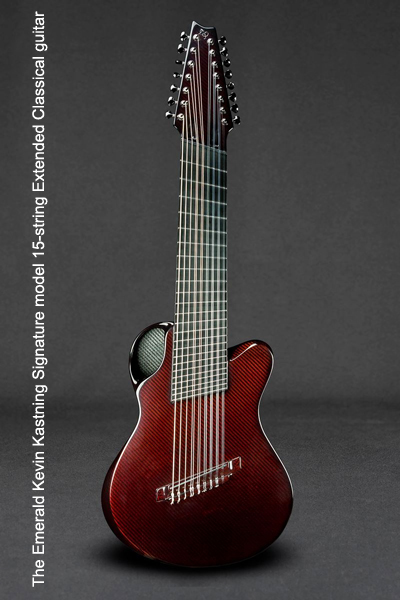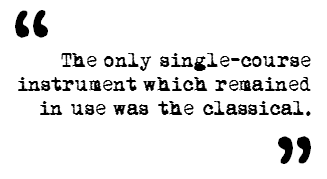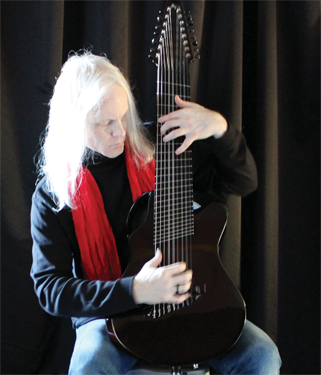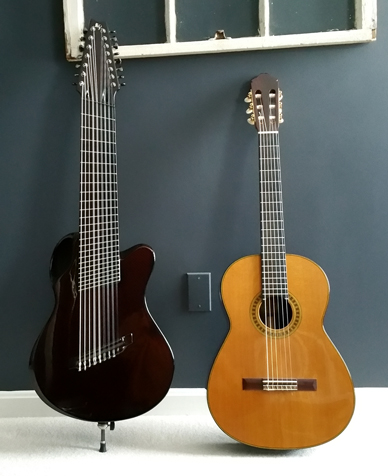
Photo Gallery Strings and Tunings
Specifications
Home

![]() ince
2014, my two main instruments for recording and concerts are the Emerald Guitars Kevin Kastning Signature 30-string
Contra-Alto guitar and the Emerald Guitars Kevin Kastning
Signature 36-string Double Contraguitar. These instruments appear on the Greydisc albums
Dark Sonatas,
Nowhere, Now Here, Watercolor Sky,
and In Stories.
ince
2014, my two main instruments for recording and concerts are the Emerald Guitars Kevin Kastning Signature 30-string
Contra-Alto guitar and the Emerald Guitars Kevin Kastning
Signature 36-string Double Contraguitar. These instruments appear on the Greydisc albums
Dark Sonatas,
Nowhere, Now Here, Watercolor Sky,
and In Stories.
Origin
In addition to my two main instruments, I also use a 6-string classical
guitar. It is a 2008 Cervantes Rodriguez Concert model. It
provides an entirely different voice which contrasts greatly with the 30-string
and 36-string voices. However, in all the years I've had it, I've felt
single-courses to be a severe limitation for me. My main instruments since 2006
have all been double-course instruments, and the only single-course instrument
which remained in use was the classical. I loved and needed the voice of
the classical guitar in my music, so I pressed on with it. I really had no
choice, as there is no such instrument as a double-course classical guitar.
Even though, I still had it in my mind that at some point I would investigate
the possibility of designing and commissioning one. However, I wasn't sure
it would be possible in a wood instrument. Classical guitars are built
very lightly, and are far more delicate than their steel-string counterparts.
An extended classical would add close to three times the string pull, and would
destroy any known classical. Of course, luthiers design and build
instruments with the pounds of force generated by the strings taken well into
account, but adding the extra weight and material required for this instrument
might well leave it with very little voice at all. I knew if it were to be
successful, it would have to be a carbon fiber instrument. Based on my
experience with the KK-30 and the KK-36,
I also suspected that a carbon fiber instrument could solve some of the the
issues I've had with all classical guitars: the imbalance of the G string, the
lack of a balanced treble response, and limited sustain in the treble strings.
pressed on with it. I really had no
choice, as there is no such instrument as a double-course classical guitar.
Even though, I still had it in my mind that at some point I would investigate
the possibility of designing and commissioning one. However, I wasn't sure
it would be possible in a wood instrument. Classical guitars are built
very lightly, and are far more delicate than their steel-string counterparts.
An extended classical would add close to three times the string pull, and would
destroy any known classical. Of course, luthiers design and build
instruments with the pounds of force generated by the strings taken well into
account, but adding the extra weight and material required for this instrument
might well leave it with very little voice at all. I knew if it were to be
successful, it would have to be a carbon fiber instrument. Based on my
experience with the KK-30 and the KK-36,
I also suspected that a carbon fiber instrument could solve some of the the
issues I've had with all classical guitars: the imbalance of the G string, the
lack of a balanced treble response, and limited sustain in the treble strings.
Design and Build
In early 2014, I spoke with Alistair
Hay at Emerald in
Ireland about the concept of a double-course classical guitar. I wasn't
entirely sure about the number of courses, but I knew they had to be double
courses. And I wanted to expand the current 6-string range of the
classical guitar with additional courses. I did some tests on my classical using
much heavier gauges for the low E, and tuning it down to B and F#. I knew
these pitches were possible, so I added both B and F# below E to the spec.
The low F# adds almost a full octave below the bass E course. I then began experimenting with much lighter gauges on the 1st string, and
tuning it up to A above E. This also proved to be successful, so A was
added, and I now had a 9-course classical in the early design stages.
Although the string tension of the B, F#, and high A courses wasn't even when
compared to the rest of the strings, I knew this problem could be solved as we
delved further into the design.
Further research into the low B and F# courses showed that due to the wide string vibrational arc, using double-courses for the low F#, B, and E courses would not work. Hence, these three bass courses would be single-courses, with all others being double-courses. That made for a total of 15 strings: three single-courses, and six double-courses.
Throughout 2014 and into early 2015, Alistair and I exchanged many emails about this project, and discussed specs, design, and some unforeseen challenges during late-night Skype sessions. I finalized a spec, and the building process began in late 2014.
Evolution
Fan-fret (multiscale) -- Visually, the most obvious feature is the
fan-fret, or
multiscale design. The scale length is based on a 650mm
scale, with the fan spreading between 271/4 inches on the bass side, and 241/2 inches
on the treble side. This provides a different scale length for each
string. Alistair strongly suggested we go with a fan-fret, as
this would better allow the wide range of string pitches to sound better,
be more in
 balance both in voice and tension, and avoid string breakage to due to overly-high tension in
the trebles. Multiscale seems like a modern concept, but was actually
developed for the
Orpharion, a lute-family instrument, in 1581. The multiscale proved to
be perfect for this instrument; the string tensions are even, and the tonal
response is very balanced across all registers. The playability of the
multiscale feels very natural, even in the cello position.
balance both in voice and tension, and avoid string breakage to due to overly-high tension in
the trebles. Multiscale seems like a modern concept, but was actually
developed for the
Orpharion, a lute-family instrument, in 1581. The multiscale proved to
be perfect for this instrument; the string tensions are even, and the tonal
response is very balanced across all registers. The playability of the
multiscale feels very natural, even in the cello position.
Cello -- One feature on both the 30 and the 36 is the addition of a cello
endpin. I play these instruments in a
vertical cello position.
 I knew with the much wider neck of the extended classical that a cello position
would be best, so a cello endpin was added to the spec.
I knew with the much wider neck of the extended classical that a cello position
would be best, so a cello endpin was added to the spec.
Soundhole -- The soundhole is in the upper bout of the bass side, and is cut into both the top and the side of the upper bout. Carbon fiber instruments project extremely well, so this soundhole design helps to further focus the sound.
Pickups -- For the extended classical, I knew I wanted a pickup system instead of an internal mic, and not an undersaddle transducer. As I am an artist endorser for K&K Sound, makers of my favorite pickup systems, I began speaking with Dieter at K&K about a specially designed stereo Pure Mini pickup system. Dieter created a wonderful system; the pickups sound very similar to microphones. In concert settings, this provides a very natural and realistic sound without the feedback issues of internal mic systems. I've also been experimenting with mixing the stereo K&K system with the four-mic setup in the recording studio.
Fingerboard -- Like 6-string classical guitars, the KK15 has a non-radiused fingerboard. Unlike any classical guitar, the KK15 has a full 24 frets. Instead of the usual nickel silver fret material, frets on the KK15 are stainless steel.
Alistair Hay:
"Ever since I received the first email from Kevin Kastning a few years ago
things haven’t quite been the same since.
Kevin has a very individual style of playing which requires some very specific
and highly unusual instruments that just weren’t really feasible in wood but
then our paths collided and what once seemed impossible now seemed achievable.
 After
building the Kevin Kastning Contra-Alto 30-string and the KK36 36-string Double
Contraguitar guitars for Kevin, I had always suspected another equally
challenging instrument would be just around the corner and sure enough Kevin set
me the challenge and as I haven't yet learnt the word NO I proceeded to say
"yes, no problem."
After
building the Kevin Kastning Contra-Alto 30-string and the KK36 36-string Double
Contraguitar guitars for Kevin, I had always suspected another equally
challenging instrument would be just around the corner and sure enough Kevin set
me the challenge and as I haven't yet learnt the word NO I proceeded to say
"yes, no problem."
During the build of the previous two instruments, I had suggested the use of fan
frets to allow for the very wide array of tuning but in the end we decided for
those we could accommodate the design with regular frets. But for this
instrument where Kevin wanted to go right up as far as high A it seemed like the
only possible answer.
Fan frets are a scary proposition but I convinced Kevin that if I could handle
fan frets with my mediocre playing then to him it would barely be noticeable.
I'm
 |
|
|
KK15 and Cervantes classical: size comparison |
|
|
|
glad I won him over as truly the fan fret design is the basis by which the
success of this instrument lies.
The treble side is just short enough to allow a high A with a special
fluorocarbon string type that Kevin sent me and with the use of heavy nylon bass
strings we were able to achieve a strong low bass note as well.
Once again Kevin set quite a challenge, but it's the challenge and the
collaboration of ideas that I love.
Now I wonder if I could convince Kevin of a novel idea: a guitar with 6
strings?"
The Way Forward
The KK15 arrived in March 2015. Alistair created an instrument of stunning
aural beauty and depth. My suspicions about carbon fiber resolving the
limitations of classical guitars proved to be correct: the G string imbalance is
gone, the treble register is crisp and sparkling without being thin, and the
sustain is greatly improved. The voicing, the responsiveness, the
balance, the playability, and the flawless action are wonderful. The intonation is very accurate; no mean feat on a
multiscale instrument with 15
strings. I
feel as if the KK15 provides a balance to my instrument palette which was sorely
lacking. It will be on several album recording projects
in 2015 and beyond.
To Alistair and everyone at Emerald Guitars in Ireland, my sincere gratitude.
– Kevin Kastning
Massachusetts, US
22 March 2015
Hover over center of main image for slideshow controls.
15-string classical
Body: X20
Bridge: classical tie-on type
Neck: Fan-fret, based on 650mm scale
Multiscale dimensions: 27.25 inches bass side to 24.5 inches treble side
Nut width: 3.75 inches / 95mm
24 frets
Saddle spacing: 101mm
Saddle: Graphtech custom
Total weight: 3.0kg / 6 lb. 9 oz.
Fingerboard radius: flat
Double truss rods
Cello end pin
K&K stereo system (bass side = stereo L / treble side = stereo R)
Tuners: Gotoh 18:1 metro black
Color: red
F# B E AA DD GG BB EE AA
(or)
F# B E Aa Dd Gg Bb EE AA
For actual string gauges and string types, refer to the Strings and Tunings page.
Other instruments in the Emerald Kevin Kastning Signature series:
The Emerald Kevin Kastning Signature model 30-string Contra-Alto guitar
The Emerald Kevin Kastning Signature model 36-string Double Contraguitar
The Kevin Kastning Signature model 15-string Extended Classical guitar at Emerald Guitars